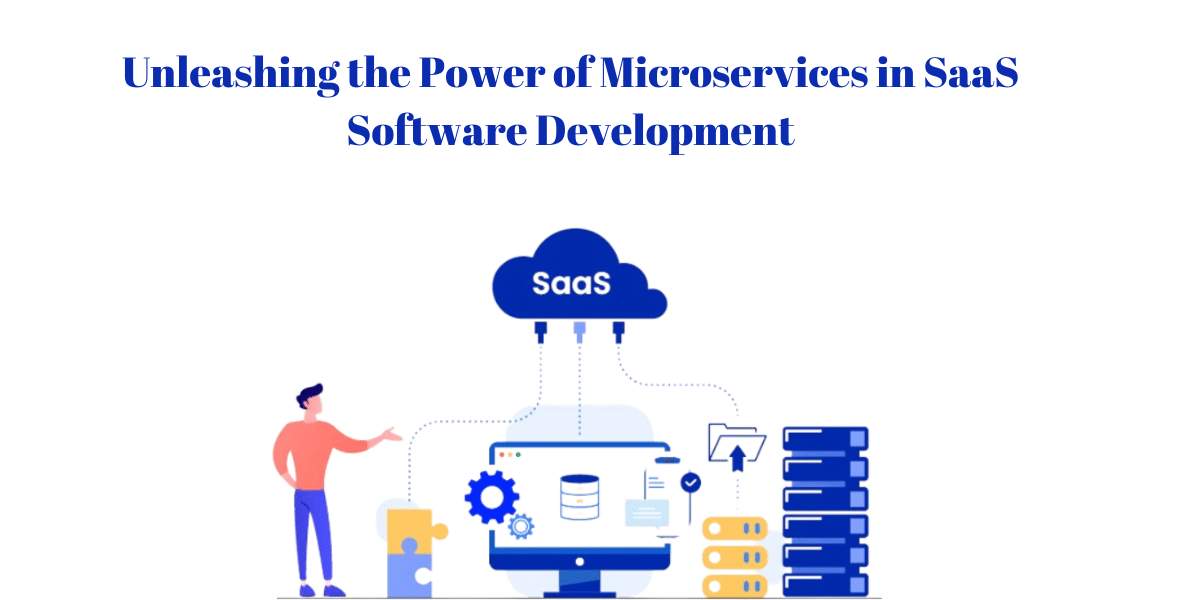In the dynamic landscape of Software as a Service (SaaS) development, harnessing the power of microservices has emerged as a transformative paradigm, revolutionizing how applications are conceived, designed, and deployed. The introduction of microservices architecture represents a departure from traditional monolithic structures, offering a modular and scalable approach to software development. This shift enables development teams to build, deploy, and update components independently, fostering agility, flexibility, and rapid innovation.
Microservices architecture breaks down complex applications into smaller, self-contained services that operate collaboratively. Each microservice serves a specific business function, promoting better maintainability and scalability. This introduction explores the fundamental principles, benefits, and challenges associated with unleashing the power of microservices in the realm of SaaS software development.
From scalability and fault isolation to containerization and deployment strategies, this paradigm empowers SaaS developers to enhance efficiency, streamline processes, and deliver cutting-edge solutions in an ever-evolving digital landscape. Join us on a journey through the intricacies of microservices, unlocking their potential to shape the future of SaaS software development.
Key Principles of Microservices Architecture
Microservices architecture is guided by several key principles that collectively define its approach to software development. At its core, microservices emphasize the decomposition of complex applications into smaller, independent services, each dedicated to a specific business capability. This modularization facilitates agility and scalability, allowing development teams to focus on individual components without being encumbered by the intricacies of an overarching monolith.
A central tenet of microservices lies in the autonomy of these individual services. Each microservice operates as an independent entity, possessing its own database and runtime environment. This autonomy ensures that changes or updates to one microservice do not impact others, promoting a decentralized and resilient system. Additionally, microservices adhere to the principle of bounded context, wherein each service defines clear boundaries for its functionality, data, and interactions. This encapsulation fosters maintainability and enables teams to evolve services independently, aligning with the specific needs of their respective domains.
Another fundamental principle is the emphasis on communication through APIs (Application Programming Interfaces). Microservices communicate with each other through well-defined APIs, enabling seamless integration and collaboration. This approach facilitates flexibility, allowing developers to choose the most suitable technology stack for each microservice, promoting innovation and adaptability.
Furthermore, microservices embrace a decentralized data management strategy. Each service manages its own database, minimizing dependencies and mitigating the risk of a single point of failure. This distributed nature enhances the system’s overall resilience and supports the scalability required in modern, dynamic SaaS environments. In essence, the key principles of microservices architecture, encompassing autonomy, bounded context, API-driven communication, and decentralized data management, collectively empower development teams to navigate the complexities of modern SaaS software development with agility, scalability, and resilience.
Advantages of Adopting Microservices in SaaS
The adoption of microservices architecture in Software as a Service (SaaS) development offers a multitude of advantages that significantly impact the efficiency, scalability, and overall success of software applications. One key advantage lies in the enhanced agility microservices provide. By breaking down a monolithic application into smaller, independently deployable services, development teams gain the flexibility to update, modify, or scale individual components without affecting the entire system. This agility accelerates the development cycle, allowing for rapid iterations and quicker response to market demands.
Scalability is another paramount advantage of microservices in the SaaS domain. With a modular structure, each microservice can be scaled independently based on its specific workload, optimizing resource allocation and ensuring efficient utilization of computing resources. This granular scalability is particularly crucial in dynamic SaaS environments where user demands fluctuate, allowing applications to seamlessly adapt to varying workloads.
Microservices also foster improved fault isolation. In a monolithic architecture, a failure in one component can potentially impact the entire application. Microservices, on the other hand, confine faults to specific services, preventing them from cascading throughout the system. This isolation enhances system resilience and ensures that issues are localized, making it easier to identify, troubleshoot, and rectify problems swiftly.
Furthermore, microservices facilitate technology diversity, enabling development teams to use different programming languages and frameworks for each service. This flexibility empowers teams to choose the most suitable technology stack for specific functionalities, promoting innovation and accommodating diverse skill sets within the development team.
In summary, the advantages of adopting microservices in SaaS, including enhanced agility, scalability, fault isolation, and technology diversity, collectively contribute to the creation of more resilient, adaptable, and efficient software applications in the ever-evolving landscape of SaaS development.
Scalability and Elasticity with Microservices
Scalability and elasticity represent two cornerstones of microservices architecture, playing pivotal roles in addressing the dynamic demands of modern software applications. Microservices offer an inherent scalability that stems from their modular and independent nature. Each microservice functions as a discrete unit, allowing developers to scale individual components in response to specific performance requirements. This granular scalability contrasts with the challenges posed by monolithic architectures, where scaling often involves replicating the entire application, irrespective of the specific component’s demand.
Elasticity, closely related to scalability, extends the concept by providing the ability to dynamically adapt to varying workloads. Microservices empower applications to scale both horizontally and vertically, accommodating changes in user demand without compromising performance. Horizontal scaling involves adding more instances of a particular microservice to distribute the load, while vertical scaling involves enhancing the resources allocated to a specific microservice. This flexibility enables applications to efficiently allocate resources based on real-time demands, optimizing cost-effectiveness and performance.
Furthermore, microservices architecture aligns seamlessly with cloud computing environments, facilitating auto-scaling capabilities. Cloud platforms can automatically adjust the number of instances for each microservice based on predefined metrics, ensuring optimal resource utilization and cost efficiency. This auto-scaling ability is particularly valuable in SaaS development, where user demand can fluctuate dramatically.
In conclusion, the scalability and elasticity inherent in microservices architecture empower developers to create agile and responsive software applications. The modular, independent nature of microservices enables precise scalability, while elasticity ensures dynamic adaptability to varying workloads, ultimately optimizing performance and resource utilization in the ever-evolving landscape of software development.
Microservices vs. Monolithic Architecture in SaaS
The choice between microservices and monolithic architecture represents a critical decision in the realm of Software as a Service (SaaS) development, each approach presenting distinct advantages and challenges. Monolithic architecture, characterized by a single, tightly integrated application, offers simplicity and ease of development. In a monolith, all components share the same codebase and database, simplifying deployment and maintenance. However, this simplicity can become a limitation as the application scales or evolves, hindering agility and flexibility.
On the other hand, microservices architecture addresses the limitations of monoliths by decomposing the application into smaller, independently deployable services. Microservices promote modularization, allowing development teams to focus on specific functionalities and update individual components without affecting the entire system. This approach fosters agility and scalability, crucial in the fast-paced and dynamic landscape of SaaS development. However, the benefits of microservices come with increased complexity in terms of communication between services, deployment strategies, and the need for robust infrastructure.
The comparison between microservices and monolithic architecture extends to scalability and resource utilization. Monoliths scale by replicating the entire application, potentially leading to inefficiencies when specific components experience higher demand. Microservices, with their granular scalability, enable precise resource allocation to individual services, optimizing performance and cost-effectiveness.
In summary, the choice between microservices and monolithic architecture in SaaS development involves a trade-off between simplicity and flexibility. Monoliths may be suitable for straightforward applications, while microservices offer a scalable and agile solution for complex, evolving SaaS platforms. The decision hinges on the specific requirements, goals, and complexities of the software being developed.
Decomposing Monoliths: Strategies for Migration
Decomposing monolithic applications into a microservices architecture is a strategic imperative for organizations seeking to enhance agility and scalability in their software development. Several key strategies exist for successfully navigating this migration process.
One common approach is the Strangler Fig Pattern, where new functionalities and features are developed as microservices alongside the existing monolith. Over time, these microservices gradually take over the responsibilities of the monolith, eventually strangling and replacing it. This incremental migration mitigates risks associated with a wholesale transition, allowing for a seamless integration of microservices into the existing system.
Another strategy involves Domain-Driven Design (DDD) principles, where the monolith is dissected based on distinct business domains. By identifying and isolating specific functionalities into microservices aligned with these domains, development teams can incrementally transition components without disrupting the entire system. This method aligns with the principle of bounded context, ensuring that each microservice encapsulates a well-defined business capability.
Furthermore, API Gateway Integration can be employed to orchestrate communication between microservices and the monolith. This approach involves creating an API gateway that manages requests and responses, gradually diverting traffic to microservices. This allows for a controlled transition, enabling organizations to address challenges related to data consistency, dependencies, and communication patterns.
In summary, strategies for decomposing monoliths into microservices are multifaceted, and the choice depends on the specific context and goals of the organization. Whether through the Strangler Fig Pattern, Domain-Driven Design, API Gateway Integration, or a combination of these approaches, a thoughtful and phased migration strategy is essential for realizing the benefits of microservices architecture while minimizing disruption to existing systems.
Microservices Communication Patterns in SaaS
Effective communication between microservices is fundamental to the success of a Software as a Service (SaaS) application built on a microservices architecture. Various communication patterns are employed to facilitate seamless interaction between these distributed components, ensuring cohesiveness and functionality across the system.
RESTful APIs
Representational State Transfer (REST) is a widely adopted communication pattern that utilizes standard HTTP methods to enable communication between microservices. RESTful APIs provide a stateless and scalable approach, allowing services to interact over the web. This simplicity makes REST a popular choice for exposing and consuming microservices in SaaS applications.
Message Queues
Asynchronous communication is often facilitated through message queues, where microservices exchange messages without direct coupling. Messaging patterns, such as publish-subscribe or point-to-point queues, enhance scalability and decouple services, enabling them to operate independently and asynchronously. Popular message queue technologies like RabbitMQ or Apache Kafka play a crucial role in managing these communication patterns.
gRPC (Remote Procedure Call)
gRPC is a modern communication protocol that facilitates efficient and lightweight communication between microservices. Based on protocol buffers, gRPC allows for the definition of service methods and data structures, supporting both synchronous and asynchronous communication. Its efficiency and versatility make it a compelling choice for microservices in scenarios where low latency is critical.
Event-Driven Architecture
Microservices often leverage event-driven communication, where services emit and consume events to signal changes in state or trigger specific actions. This pattern promotes loose coupling, scalability, and real-time responsiveness, making it suitable for scenarios where services need to react to changes in the system.
In conclusion, the choice of communication patterns in SaaS microservices architecture depends on factors such as latency requirements, data consistency, and the specific needs of the application. A thoughtful combination of these patterns can create a robust and responsive ecosystem of microservices, ensuring the seamless functioning of a dynamic SaaS platform.
Containerization and Orchestration in Microservices
Containerization and orchestration play integral roles in the effective deployment, scaling, and management of microservices within a Software as a Service (SaaS) architecture. Containerization, exemplified by technologies like Docker, encapsulates each microservice and its dependencies into lightweight, portable containers. These containers ensure consistency across various environments, mitigating the classic “it works on my machine” issue and simplifying the deployment process. The isolation provided by containers allows microservices to run reliably and independently, contributing to the scalability and agility essential in the dynamic landscape of SaaS development.
Orchestration, often facilitated by tools like Kubernetes, takes containerization to the next level by automating the deployment, scaling, and management of containerized applications. Kubernetes, for instance, orchestrates the deployment of microservices across a cluster of machines, ensuring optimal resource utilization and high availability. It manages container scaling based on demand, rolling updates, and automated load balancing, streamlining the operational aspects of a microservices-based SaaS application.
The combined use of containerization and orchestration provides several advantages. It enhances scalability, allowing microservices to scale up or down based on demand seamlessly. It also simplifies the management of microservices by automating tasks such as health monitoring, fault recovery, and deployment updates. Moreover, these technologies contribute to the efficient utilization of resources, making them well-suited for the cloud-native paradigm often adopted in SaaS environments.
In summary, containerization and orchestration form a dynamic duo that empowers SaaS developers to build, deploy, and manage microservices at scale. The portability, isolation, and automation they provide are crucial elements in achieving the flexibility and efficiency required in the ever-evolving landscape of microservices-based SaaS development.
Microservices Security Best Practices
Ensuring robust security in a microservices architecture is paramount to safeguarding sensitive data and maintaining the integrity of a Software as a Service (SaaS) application. Several best practices are essential for addressing the unique security challenges posed by the distributed nature of microservices.
Zero Trust Security Model
Adopting a zero-trust approach entails verifying every request, regardless of its origin. Microservices within a SaaS application should authenticate and authorize each other, enforcing the principle that trust should not be assumed based solely on network location.
Secure Communication
Employing Transport Layer Security (TLS) for encrypting communication between microservices is fundamental. This ensures that data exchanged between services remains confidential and protected from eavesdropping. Additionally, using mutual TLS authentication enhances the security posture by verifying the identities of both the sender and receiver.
Role-Based Access Control (RBAC)
Implementing RBAC helps restrict access to microservices based on the roles and responsibilities of the users or services. This minimizes the attack surface and ensures that only authorized entities can interact with specific functionalities.
API Security
Microservices communication often occurs through APIs, necessitating robust API security measures. This includes proper validation of input data, securing endpoints, and implementing rate limiting to prevent abuse. Additionally, employing tools like API gateways can add an extra layer of security by managing and securing the API traffic.
Container Security
As microservices are often encapsulated in containers, ensuring container security is crucial. Regularly scanning container images for vulnerabilities, applying security patches, and implementing least privilege principles within containers contribute to a more secure deployment.
By adhering to these microservices security best practices, organizations can fortify their SaaS applications against potential threats, ensuring a resilient and trustworthy ecosystem for both users and the underlying infrastructure.
Fault Isolation and Resilience in Microservices
Fault isolation and resilience are critical aspects of microservices architecture, addressing the challenges associated with the distributed nature of Software as a Service (SaaS) applications development. In a microservices ecosystem, where individual services operate independently, it is essential to implement strategies that mitigate the impact of failures and enhance overall system reliability.
Circuit Breaker Pattern
The Circuit Breaker pattern is a fault-isolation mechanism that monitors the health of a microservice. If the service experiences repeated failures, the circuit breaker “opens,” temporarily halting requests to prevent further damage. This pattern enables the system to gracefully degrade in the face of failures, giving other services the opportunity to handle requests or providing a fallback mechanism.
Bulkhead Patter
Inspired by ship design, the Bulkhead pattern involves segregating components of the system to prevent the failure of one from affecting others. In microservices, this can be applied by isolating services into separate thread pools or containers, ensuring that faults in one service do not propagate to others.
Retry Mechanisms
Implementing retry mechanisms at the communication level between microservices helps mitigate transient faults. Services can be configured to automatically retry requests in the event of failures, allowing for the potential recovery of the service without impacting the end-user experience.
Graceful Degradation
Microservices should be designed to gracefully degrade when facing increased loads or failures. This involves prioritizing critical functionalities and simplifying or disabling non-essential features during periods of stress, ensuring that the core aspects of the system remain operational.
Chaos Engineering
Proactively testing a microservices system under controlled, chaotic conditions helps identify vulnerabilities and weaknesses. By intentionally introducing faults or failures and observing the system’s response, organizations can iteratively improve fault tolerance and resilience.
In summary, fault isolation and resilience in microservices are achieved through a combination of architectural patterns, proactive testing, and thoughtful design considerations. These strategies enhance the overall robustness of a SaaS application, ensuring that it can effectively navigate challenges and provide a reliable experience for users, even in the face of component failures.
Monitoring and Logging for Microservices in SaaS
Monitoring and logging are indispensable components in the operational toolkit of a microservices-based Software as a Service (SaaS) application, providing crucial insights into the health, performance, and behavior of individual services. In the dynamic and distributed nature of microservices architecture, effective monitoring and logging strategies are essential for diagnosing issues, optimizing performance, and ensuring a seamless user experience.
Distributed Tracing
Implementing distributed tracing mechanisms allows organizations to track the flow of requests as they traverse through various microservices. This provides visibility into the end-to-end journey of a user request, helping identify bottlenecks, latency issues, and dependencies between services. Tools like OpenTelemetry and Zipkin facilitate the implementation of distributed tracing.
Centralized Logging
Aggregating logs from different microservices into a centralized location streamlines the troubleshooting process. Centralized logging platforms such as ELK Stack (Elasticsearch, Logstash, Kibana) or Splunk enable teams to analyze logs collectively, aiding in the detection of patterns, anomalies, and potential security threats across the entire SaaS application.
Real-time Monitoring
Utilizing real-time monitoring tools allows organizations to proactively identify and respond to issues as they arise. Metrics related to service health, resource utilization, and response times provide a comprehensive understanding of the system’s current state. Prometheus and Grafana are popular choices for real-time monitoring and visualization in microservices environments.
Alerting Systems
Establishing robust alerting systems based on predefined thresholds or anomaly detection helps teams promptly address issues before they impact users. Alerts can be triggered for performance degradation, error rates, or other critical metrics, enabling rapid response and minimizing downtime.
Log Retention and Compliance
Ensuring proper log retention practices is essential for compliance and auditing purposes. Microservices should adhere to log retention policies, preserving logs for an appropriate duration to meet regulatory requirements while efficiently managing storage resources.
In conclusion, monitoring and logging in microservices contribute to the proactive management of a SaaS application, offering visibility into its performance, identifying potential issues, and facilitating rapid responses to ensure a reliable and resilient user experience. Adopting a comprehensive monitoring and logging strategy is essential for organizations seeking to optimize their microservices architecture and deliver a robust SaaS solution.
Microservices Deployment Strategies
Microservices deployment strategies are essential for ensuring seamless and efficient delivery of software in a Software as a Service (SaaS) environment. The dynamic and modular nature of microservices allows for various deployment approaches, each catering to specific requirements and goals.
Blue-Green Deployment
This strategy involves maintaining two identical production environments, namely the “blue” and “green” environments. At any given time, one environment serves live user traffic (production), while the other is used for deployment and testing. This approach enables quick and risk-free rollbacks in case issues arise during deployment, ensuring minimal downtime and a smooth transition between versions.
Canary Deployment
In a canary deployment, new versions of microservices are gradually rolled out to a subset of users or servers before being deployed to the entire system. This incremental release allows for real-time monitoring of the new version’s performance and helps identify potential issues before full deployment. Canary deployments minimize the impact of potential bugs or performance issues on the entire user base.
Feature Toggles (Feature Flags)
Feature toggles involve deploying new features to production but keeping them hidden or inactive until they are ready for release. This strategy allows development teams to decouple deployment from release, enabling the activation of features at a later time without requiring a new deployment. Feature toggles enhance flexibility and facilitate controlled feature rollouts.
Rolling Deployment
In a rolling deployment, new versions of microservices are incrementally deployed across the production environment, one at a time. This process ensures continuous availability of the application while gradually updating each instance. Rolling deployments are effective in scenarios where maintaining uptime is crucial, as they minimize the risk of service disruption.
A/B Testing
A/B testing involves deploying two or more versions of a microservice concurrently and directing a subset of users to each version. This strategy allows organizations to compare the performance, user experience, and effectiveness of different versions, aiding in data-driven decision-making before full deployment.
These microservices deployment strategies empower organizations to manage updates, mitigate risks, and maintain a high level of availability in their SaaS applications. The choice of deployment strategy depends on factors such as the application’s architecture, the level of risk tolerance, and the desired balance between agility and stability in the deployment process.
Testing Strategies for Microservices-based SaaS Applications
Testing strategies for microservices-based Software as a Service (SaaS) applications are crucial to ensure the reliability, performance, and functionality of the individual services and the overall system. Given the distributed nature of microservices, testing becomes more intricate, necessitating a comprehensive approach.
Unit Testing
At the microservices level, unit testing remains foundational. Each microservice should undergo rigorous unit testing to validate the correctness of its logic and functionality in isolation. Automated unit tests help identify and rectify issues early in the development process.
Integration Testing
Integration testing focuses on verifying the collaboration and interoperability of multiple microservices. This involves testing the interactions between services, ensuring that they exchange data and communicate seamlessly. Tools like Docker and container orchestration platforms can facilitate integration testing by providing isolated environments for testing microservices interactions.
Contract Testing
Contract testing involves validating the contracts or agreements between microservices to ensure they can work together effectively. This approach ensures that changes in one microservice do not adversely impact others, promoting the autonomy and independence of each service.
End-to-End Testing
End-to-end testing evaluates the functionality of the entire SaaS application by simulating real user scenarios. This type of testing is critical for identifying issues related to the integration of various microservices, data consistency, and the overall user experience.
Performance Testing
Given the potential scalability challenges in microservices, performance testing is essential to assess the responsiveness and stability of the application under various loads. This includes load testing, stress testing, and scalability testing to identify performance bottlenecks and ensure the application can handle peak loads.
Chaos Engineering
Introducing controlled chaos into the system through chaos engineering helps simulate real-world failure scenarios and assess the system’s resilience. By intentionally inducing failures and monitoring how the system responds, organizations can proactively identify weaknesses and enhance fault tolerance.
In conclusion, testing strategies for microservices-based SaaS applications should encompass a combination of unit testing, integration testing, contract testing, end-to-end testing, performance testing, and chaos engineering. A robust testing strategy ensures the reliability and scalability of individual microservices and the cohesiveness of the entire SaaS application, allowing organizations to deliver a high-quality and resilient software product to users.
Challenges in Adopting Microservices in SaaS Development
The adoption of microservices in Software as a Service (SaaS) development, while offering numerous benefits, introduces several challenges that organizations must navigate to harness the full potential of this architectural paradigm.
Complexity of Distributed Systems
Microservices inherently introduce complexity by breaking down applications into smaller, independently deployable services. Managing the communication, coordination, and dependencies between these services can be intricate, requiring a robust infrastructure and careful design to avoid issues like service discovery challenges and increased latency.
Data Management and Consistency
Microservices often have their own databases, leading to challenges in maintaining data consistency across the entire system. Implementing effective strategies for data synchronization, transactions, and ensuring eventual consistency becomes critical to avoid discrepancies and integrity issues.
Service Discovery and Orchestration
As the number of microservices grows, discovering and orchestrating services become complex tasks. Ensuring that each microservice can dynamically discover and communicate with others, as well as coordinating their interactions, becomes a significant challenge, especially in large-scale SaaS applications.
Testing and Quality Assurance
Testing in a microservices environment demands a comprehensive strategy. Coordinating end-to-end testing, handling data isolation for independent testing of microservices, and ensuring comprehensive test coverage across the entire system pose challenges in maintaining the desired level of software quality.
Continuous Integration and Deployment (CI/CD)
Implementing effective CI/CD pipelines for microservices can be challenging due to the need for parallel testing, deployment, and versioning of numerous services. Coordinating the release of multiple microservices while maintaining system stability requires careful planning and robust automation.
Organizational Change and Skill Set
Adopting microservices often requires a shift in organizational culture and skills. Development teams need to adapt to a more decentralized, autonomous way of working, and organizations must invest in training and upskilling to ensure teams are equipped to navigate the complexities of microservices architecture.
In conclusion, while microservices offer unparalleled agility and scalability in SaaS development, addressing challenges related to distributed systems complexity, data consistency, service discovery, testing strategies, CI/CD, and organizational adaptation is crucial. Successful adoption requires a holistic approach that encompasses technology, processes, and people to unlock the full potential of microservices in the SaaS landscape.
Micro Frontends: Enhancing User Experience in SaaS
Micro Frontends, a paradigm gaining prominence in Software as a Service (SaaS) development, represents an innovative approach to enhancing user experience by extending the principles of microservices architecture to the frontend layer. Traditionally, frontend monoliths presented challenges in terms of scalability, agility, and independent development. Micro Frontends address these issues by breaking down the frontend into smaller, self-contained components that operate autonomously, aligning with the broader microservices philosophy.
One key advantage of Micro Frontends is the ability to develop and deploy frontend components independently, allowing different teams to work on distinct parts of the user interface without interfering with each other. This decoupling of frontend modules promotes agility, enabling rapid updates and feature releases. Furthermore, Micro Frontends facilitate seamless integration with various frontend frameworks and technologies, allowing teams to choose the most suitable tools for their specific requirements.
The modularity introduced by Micro Frontends aligns with the idea of delivering a personalized and dynamic user experience. Components can be updated or replaced without affecting the entire application, enabling organizations to implement A/B testing, feature toggles, and gradual rollouts to optimize the user interface based on real-time feedback and analytics.
Moreover, Micro Frontends contribute to a more maintainable and scalable frontend architecture. Teams can evolve and scale individual components independently, resulting in a more responsive and adaptable user interface. This approach is particularly advantageous in large-scale SaaS applications where frontend complexity and frequent updates are common. In summary, Micro Frontends emerge as a powerful strategy for elevating user experience in SaaS, fostering agility, maintainability, and flexibility in the frontend development process.
Data Management in Microservices Architecture
Data management in microservices architecture presents unique challenges and opportunities, demanding a thoughtful approach to handle the decentralized nature of data across multiple services. In a microservices environment, each service often has its own database, enabling autonomy and independent data management. However, this decentralization introduces complexities related to data consistency, integrity, and inter-service communication.
Database Per Service
A common practice is adopting a database-per-service model, where each microservice has its dedicated database. This approach fosters autonomy, allowing teams to choose the most suitable database technology for their specific service. However, it raises challenges related to maintaining data consistency across services, especially in scenarios where transactions span multiple microservices.
Event-Driven Architecture
Embracing event-driven architecture facilitates communication between microservices without direct database dependencies. Services can emit events when data changes, and other services can subscribe to these events, enabling loosely coupled communication. This approach enhances scalability and decouples the data flow between services, but careful design is necessary to ensure reliable event handling and eventual consistency.
API Contracts and Versioning
Establishing clear API contracts and versioning strategies is crucial for managing data interactions between microservices. Defining explicit boundaries for data communication helps minimize dependencies and ensures backward compatibility, allowing for the evolution of services without disrupting existing functionalities.
Data Caching and Replication
To optimize performance and reduce latency, microservices often implement data caching and replication strategies. Caching frequently accessed data locally within a microservice or replicating data across services can enhance response times. However, these strategies need to account for the trade-off between consistency and performance.
Polyglot Persistence
Embracing polyglot persistence allows each microservice to use the most appropriate database technology for its specific needs. While this promotes flexibility, it requires teams to manage and maintain diverse data storage solutions, necessitating expertise in multiple database technologies.
In conclusion, effective data management in microservices architecture involves striking a balance between autonomy and consistency. Embracing practices like event-driven architecture, clear API contracts, and polyglot persistence empowers development teams to overcome challenges and leverage the benefits of decentralized data management in the dynamic landscape of microservices-based applications.
Event-Driven Architecture and Microservices
Event-Driven Architecture (EDA) serves as a foundational paradigm that seamlessly integrates with microservices architecture, offering a powerful approach to communication and coordination between independent services. In a microservices environment, where each service operates autonomously, event-driven principles enhance the scalability, flexibility, and responsiveness of the overall system.
Loose Coupling
EDA promotes loose coupling between microservices by decoupling the sender of an event from its consumers. Microservices can emit events when a change occurs, and other services interested in those events can subscribe to them. This loose coupling allows services to evolve independently, minimizing dependencies and facilitating agile development.
Asynchronous Communication
EDA relies on asynchronous communication, allowing microservices to communicate without waiting for immediate responses. This asynchronous nature enhances system responsiveness, scalability, and fault tolerance. Services can process events at their own pace, accommodating varying workloads without affecting the overall system.
Real-Time Responsiveness
Events in an event-driven system are often used to convey real-time information about changes in state or data. This real-time responsiveness is crucial for applications requiring timely updates, such as notifications, user interfaces, or integrations with external systems.
Event Sourcing
Event-driven architecture aligns well with the concept of event sourcing, where the state of a system is derived from a sequence of events. Microservices can persist events and use them to reconstruct their internal state, providing a reliable and scalable mechanism for maintaining data consistency and audit trails.
Scalability and Decentralization
EDA supports the scalability requirements of microservices by allowing each service to scale independently based on its event processing needs. The decentralized nature of event-driven systems enables services to operate autonomously, fostering a dynamic and responsive architecture.
In summary, the synergy between Event-Driven Architecture and microservices architecture empowers organizations to build scalable, loosely-coupled, and responsive systems. This approach enhances the agility of development teams, enabling them to adapt to changing requirements and deliver innovative solutions in the ever-evolving landscape of distributed software development.
Continuous Integration and Continuous Deployment (CI/CD) for Microservices
Continuous Integration and Continuous Deployment (CI/CD) practices are integral components in the lifecycle of microservices development, providing a streamlined and automated approach to building, testing, and deploying individual services within a Software as a Service (SaaS) architecture. CI/CD for microservices is crucial to ensuring rapid and reliable delivery in the dynamic and distributed nature of these applications.
Continuous Integration (CI)
CI focuses on the seamless integration of code changes into a shared repository, triggering automated builds and tests. In a microservices environment, where each service may have its own codebase, CI ensures that changes made to individual services do not introduce integration issues. Automated testing is a cornerstone of CI, allowing developers to identify and rectify issues early in the development process, promoting code quality, and preventing regressions.
Continuous Deployment (CD)
CD extends the principles of CI by automating the deployment of microservices to various environments, including development, testing, and production. Microservices, being independently deployable units, benefit from CD practices that enable rapid and reliable releases. Automated deployment pipelines orchestrate the deployment process, ensuring consistency across different services and environments. CD also supports canary releases, blue-green deployments, and feature toggles, allowing for controlled and incremental rollouts.
CI/CD practices in microservices architecture enhance agility, reduce manual intervention, and accelerate the time-to-market for SaaS applications. The modularity and independence of microservices enable teams to implement CI/CD pipelines for individual services, ensuring that updates and improvements can be delivered continuously while maintaining overall system stability and reliability. In essence, CI/CD is foundational for achieving the flexibility and efficiency required in the ever-evolving landscape of microservices-based SaaS development.
Role of APIs in Microservices-based SaaS
APIs (Application Programming Interfaces) play a pivotal role in the success of microservices-based Software as a Service (SaaS) applications, acting as the glue that enables seamless communication and interaction between individual services. In a microservices architecture, where each service functions as an independent entity with a specific business capability, APIs serve as the means by which these services expose their functionalities to the rest of the system and external components.
Service Communication
APIs facilitate communication between microservices, allowing them to request and exchange data without direct dependencies. Microservices interact with each other through well-defined APIs, promoting loose coupling and enabling services to evolve independently. This modular communication approach enhances agility and scalability in the development process.
Interoperability
APIs enable interoperability by providing standardized interfaces for microservices to communicate with external systems, third-party services, or other components within the SaaS application. This interoperability fosters flexibility, allowing organizations to integrate new services or technologies seamlessly into their microservices ecosystem.
Decentralized Data Management
Microservices often manage their own data, and APIs are the mechanism through which these services expose and consume data. APIs ensure that data is exchanged in a controlled and consistent manner, supporting decentralized data management while maintaining data integrity and consistency across the system.
External Access and Innovation
APIs serve as the gateway for external access to the functionality of a SaaS application. By providing well-documented and secure APIs, organizations empower developers to build applications, integrations, and extensions on top of their microservices, fostering innovation and expanding the ecosystem around the SaaS platform.
Versioning and Evolution
APIs allow for versioning, enabling microservices to evolve independently without disrupting existing consumers. By managing versioned APIs, organizations can ensure backward compatibility, providing a smooth transition for clients and allowing for the gradual adoption of new features and functionalities.
In summary, APIs are the linchpin in microservices-based SaaS development, enabling effective communication, interoperability, and external access. Their role extends beyond mere connectivity, serving as a key enabler for flexibility, innovation, and the seamless evolution of microservices within the dynamic landscape of SaaS applications.
Microservices Governance and Compliance
Microservices governance and compliance are essential components in the management and operation of a Software as a Service (SaaS) application built on a microservices architecture. Governance ensures that microservices adhere to established standards, policies, and best practices, facilitating consistency and coherence across the entire system.
Service Standards and Policies
Governance establishes service standards and policies that govern the development, deployment, and operation of microservices. These standards encompass coding conventions, architectural principles, and operational guidelines, fostering uniformity and maintainability across services. Compliance with these standards ensures a cohesive and well-structured microservices ecosystem.
Regulatory Compliance
Microservices governance plays a crucial role in ensuring compliance with industry regulations, legal requirements, and data protection standards. Organizations operating in regulated sectors such as finance or healthcare must adhere to specific compliance frameworks, and governance mechanisms help enforce these regulations across microservices, safeguarding data integrity and privacy.
API Management
Governance extends to the management of APIs, ensuring that they are well-documented, versioned, and secure. Effective API governance enables organizations to control access, monitor usage, and maintain backward compatibility, facilitating the integration of microservices into the broader SaaS ecosystem while ensuring security and reliability.
Monitoring and Reporting
Governance frameworks include monitoring and reporting mechanisms to track the performance, availability, and security of microservices. These tools provide insights into the health of the system, enabling proactive responses to potential issues and ensuring compliance with established service-level agreements (SLAs).
Change Management
Microservices governance encompasses change management processes to handle updates, releases, and modifications to services. This includes versioning strategies, backward compatibility checks, and mechanisms for rollback in case of issues. Effective change management ensures a controlled and reliable evolution of the microservices landscape.
In summary, microservices governance and compliance are instrumental in maintaining order, consistency, and adherence to regulations within a SaaS application’s microservices architecture. By establishing and enforcing standards, ensuring regulatory compliance, managing APIs effectively, monitoring service performance, and facilitating robust change management, organizations can foster a well-governed microservices environment that aligns with both internal requirements and external regulations.
The Key Takeaway
In conclusion, the adoption of microservices in Software as a Service (SaaS) development represents a transformative shift, ushering in agility, scalability, and flexibility. The principles of microservices architecture, such as modularity, autonomy, and decentralized data management, empower organizations to respond dynamically to evolving market demands.
The seamless integration of microservices with practices like continuous integration, deployment, and effective governance ensures a resilient and efficient development ecosystem. Microservices’ ability to enhance user experiences through approaches like Micro Frontends, coupled with their role in communication through APIs and event-driven architecture, cements their position as a cornerstone in modern SaaS applications.
While challenges such as data management complexities and the need for robust testing strategies exist, the benefits of microservices in SaaS development, including fault isolation, rapid deployment, and improved scalability, make them a compelling and progressive approach for organizations aiming to stay at the forefront of the digital landscape.











